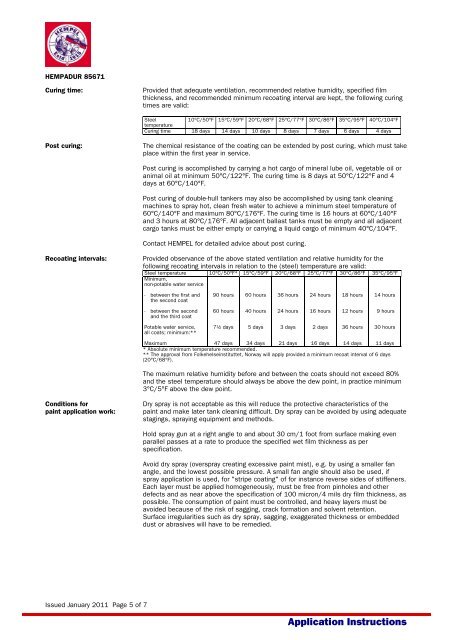English (United Kingdom) - Paul Wurth
English (United Kingdom) - Paul Wurth
English (United Kingdom) - Paul Wurth
- TAGS
- wurth
- www.paulwurth.com
You also want an ePaper? Increase the reach of your titles
YUMPU automatically turns print PDFs into web optimized ePapers that Google loves.
HEMPADUR 85671<br />
Curing time: Provided that adequate ventilation, recommended relative humidity, specified film<br />
thickness, and recommended minimum recoating interval are kept, the following curing<br />
times are valid:<br />
Issued January 2011 Page 5 of 7<br />
Steel<br />
temperature<br />
10°C/50°F 15°C/59°F 20°C/68°F 25°C/77°F 30°C/86°F 35°C/95°F 40°C/104°F<br />
Curing time 18 days 14 days 10 days 8 days 7 days 6 days 4 days<br />
Post curing: The chemical resistance of the coating can be extended by post curing, which must take<br />
place within the first year in service.<br />
Post curing is accomplished by carrying a hot cargo of mineral lube oil, vegetable oil or<br />
animal oil at minimum 50°C/122°F. The curing time is 8 days at 50°C/122°F and 4<br />
days at 60°C/140°F.<br />
Post curing of double-hull tankers may also be accomplished by using tank cleaning<br />
machines to spray hot, clean fresh water to achieve a minimum steel temperature of<br />
60°C/140°F and maximum 80°C/176°F. The curing time is 16 hours at 60°C/140°F<br />
and 3 hours at 80°C/176°F. All adjacent ballast tanks must be empty and all adjacent<br />
cargo tanks must be either empty or carrying a liquid cargo of minimum 40°C/104°F.<br />
Contact HEMPEL for detailed advice about post curing.<br />
Recoating intervals: Provided observance of the above stated ventilation and relative humidity for the<br />
following recoating intervals in relation to the (steel) temperature are valid:<br />
Steel temperature 10°C/50°F* 15°C/59°F 20°C/68°F 25°C/77°F 30°C/86°F 35°C/95°F<br />
Minimum,<br />
non-potable water service<br />
- between the first and<br />
the second coat<br />
- between the second<br />
and the third coat<br />
Potable water service,<br />
all coats; minimum:**<br />
90 hours<br />
60 hours<br />
7½ days<br />
60 hours<br />
40 hours<br />
5 days<br />
36 hours<br />
24 hours<br />
3 days<br />
24 hours<br />
16 hours<br />
2 days<br />
18 hours<br />
12 hours<br />
36 hours<br />
14 hours<br />
9 hours<br />
30 hours<br />
Maximum<br />
47 days 34 days 21 days 16 days 14 days 11 days<br />
* Absolute minimum temperature recommended.<br />
** The approval from Folkehelseinstituttet, Norway will apply provided a minimum recoat interval of 6 days<br />
(20°C/68°F).<br />
The maximum relative humidity before and between the coats should not exceed 80%<br />
and the steel temperature should always be above the dew point, in practice minimum<br />
3°C/5°F above the dew point.<br />
Conditions for Dry spray is not acceptable as this will reduce the protective characteristics of the<br />
paint application work: paint and make later tank cleaning difficult. Dry spray can be avoided by using adequate<br />
stagings, spraying equipment and methods.<br />
Hold spray gun at a right angle to and about 30 cm/1 foot from surface making even<br />
parallel passes at a rate to produce the specified wet film thickness as per<br />
specification.<br />
Avoid dry spray (overspray creating excessive paint mist), e.g. by using a smaller fan<br />
angle, and the lowest possible pressure. A small fan angle should also be used, if<br />
spray application is used, for "stripe coating" of for instance reverse sides of stiffeners.<br />
Each layer must be applied homogeneously, must be free from pinholes and other<br />
defects and as near above the specification of 100 micron/4 mils dry film thickness, as<br />
possible. The consumption of paint must be controlled, and heavy layers must be<br />
avoided because of the risk of sagging, crack formation and solvent retention.<br />
Surface irregularities such as dry spray, sagging, exaggerated thickness or embedded<br />
dust or abrasives will have to be remedied.<br />
Application Instructions




